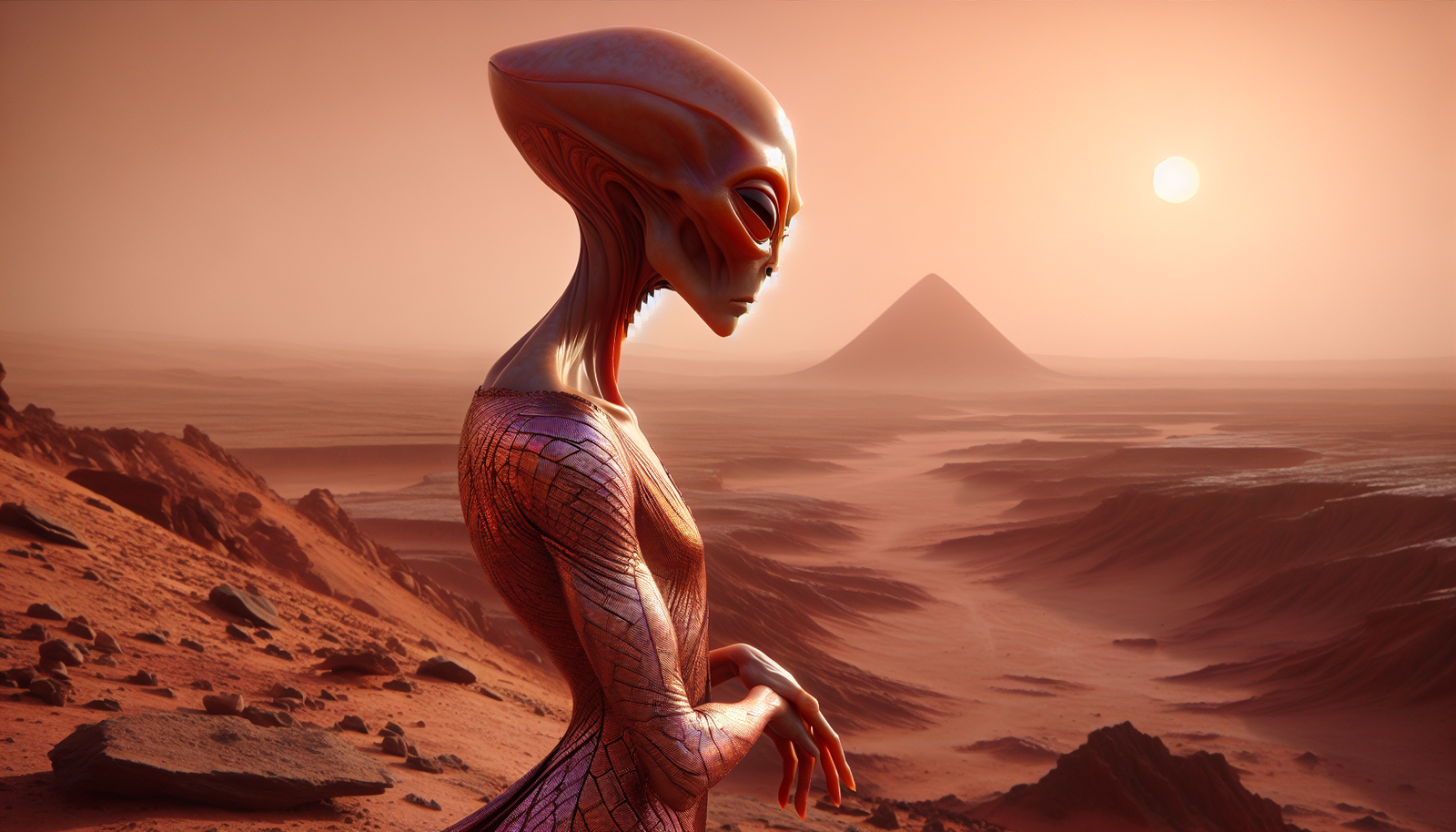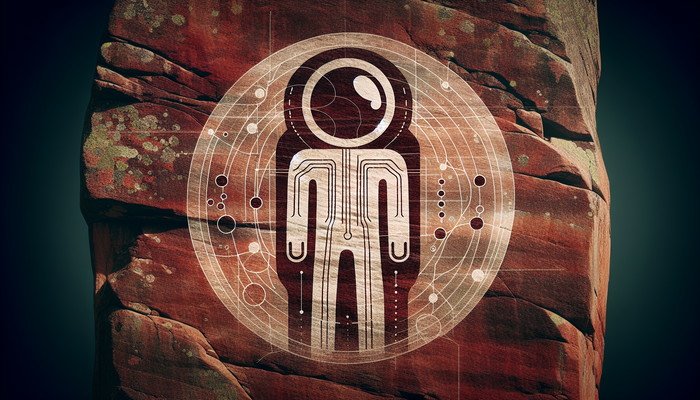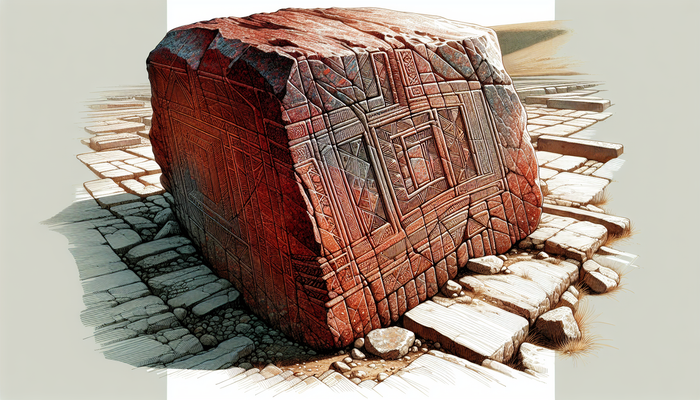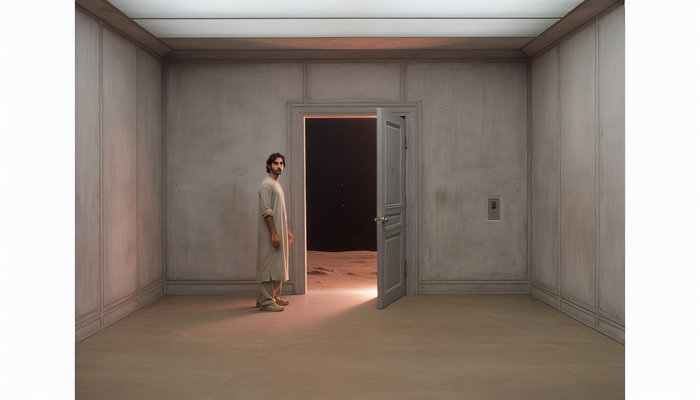Pyramids on Mars: The Definitive Story of a Modern Myth

By Elaine Westfield, Ufologist
Mars holds secrets. Or at least, that's what the grainy pixels from NASA's early missions suggested when they revealed angular shapes that looked suspiciously like pyramids scattered across the Red Planet's surface. What started as a few ambiguous photographs has evolved into one of the most persistent and captivating myths of the space age-a tale that weaves together cutting-edge planetary science, Cold War psychic espionage, ancient astronaut theories, and even a Time Lord from Gallifrey.
This isn't just a story about rocks on Mars. It's about how we humans construct meaning from shadows, how we project our deepest desires onto distant worlds, and how a modern myth is born, nurtured, and stubbornly refuses to die even in the face of overwhelming evidence to the contrary.
Genesis: When NASA Accidentally Started a Revolution
The story begins not with conspiracy theorists or science fiction writers, but with NASA's own scientists, dutifully cataloging what they saw through the electronic eyes of our first Mars orbiters.
In 1972, Mariner 9 was busy mapping Mars when it captured something odd in a region called Elysium Planitia. The images showed distinct triangular and polygonal structures casting geometric shadows across the Martian surface. These weren't tiny formations either-they measured between 3 and 6 kilometers at their bases, roughly the size of small mountains.
The discovery was significant enough that NASA researchers M. Gipson Jr. and V. K. Ablordeppey published a formal paper in 1974 titled "Pyramidal structures on Mars." They wrote with scientific restraint: "The structures cast triangular and polygonal shadows... The observed Martian structures tend to line up suggesting joint or fault control."
Their conclusion? These were likely natural formations-either volcanic cones carved by millions of years of wind erosion into sharp angles, or blocks of solidified lava that had been rotated and shaped by geological forces. But that crucial word "pyramidal" had been uttered by NASA itself. The seed was planted.
The Viking Face That Launched a Thousand Theories
Then came Viking 1 in 1976, and with it, an image that would launch a thousand websites.
Frame 70A13 captured a mesa in the Cydonia Mensae region that, under the particular lighting conditions of that Martian afternoon, looked uncannily like a massive humanoid face staring up at the stars. The mesa measured about 2.7 kilometers long-roughly the length of 30 football fields. NASA's immediate response was predictably prosaic: it was a trick of light and shadow, a textbook example of pareidolia-our brain's tendency to see faces in clouds, electrical outlets, and apparently, Martian hills.
But here's where the story gets interesting. The Face wasn't alone. In the same region, Viking 1 photographed more of those pyramid-like structures. Suddenly, it wasn't just an isolated oddity but what looked like an entire complex-a city, even. The low resolution of 1970s imaging technology (about 200 meters per pixel) left just enough ambiguity for imagination to fill in the gaps.
The Curiosity Rover's Controversial Discovery
Fast forward to 2015, and the Curiosity rover adds a new chapter. On May 7th, it photographs a much smaller pyramid-roughly car-sized-with near-perfect triangular proportions. The YouTube channel Paranormal Crucible seizes on the image, suggesting it could be "the capstone of a much larger pyramid possibly buried deep beneath the surface."
UFO website Exopolitics goes further, claiming NASA deliberately avoided taking follow-up photos. "It appears that the NASA operators of Curiosity deliberately chose not to take another photo or zoom in on the pyramid," they write, implying a cover-up. NASA's response? They name the rock "Jake Matijevic" after a beloved engineer who had recently passed away-a touching tribute that conspiracy theorists saw as an attempt to mundanely domesticate the extraordinary.
The Architects of a Martian Dream
If NASA provided the raw materials, it was independent researchers who built the mythology. Chief among them was Richard Hoagland, whose book "The Monuments of Mars: A City on the Edge of Forever" transformed scattered anomalies into a coherent narrative of ancient alien civilization.
Hoagland didn't see random hills and shadows. He saw the ruins of a vast city, with the Face as a crumbling monument comparable to Egypt's Sphinx. His crown jewel was what he called the "D&M Pyramid" (named after discoverers Vincent DiPietro and Gregory Molinar)-a five-sided structure that he claimed displayed impossibly precise geometry.
Mathematical Messages in Martian Stone
But Hoagland went beyond simple identification. He claimed these structures encoded complex mathematical relationships. The angles between various features supposedly revealed constants like π (pi) and Φ (the golden ratio). Even more dramatically, he argued that the entire complex was astronomically aligned to mark the Martian summer solstice-but not the current one. No, these structures pointed to a solstice configuration from 500,000 years ago, suggesting that's when they were built.
"The City and the Face are aligned to allow the observation of the Summer Solstice," Hoagland wrote, describing how an ancient Martian could stand in the city and watch the sun rise over the Face against a distant cliff that may have been artificially constructed for this purpose.
The Cydonia Institute's Modern Investigations
George J. Haas of The Cydonia Institute carried the torch into the 21st century, armed with higher-resolution images from newer Mars missions. Where skeptics saw better pictures revealing natural formations, Haas saw even more evidence of artificiality. He identified what he called:
- The "Keyhole Structure" in Libya Montes-a formation combining a wedge shape with a circular dome that he argued was too symmetrical for nature. He published his analysis in the Journal of Space Exploration, lending it a veneer of academic credibility.
- The "Parrot Geoglyph" in Argyre Basin pushed the claims from architecture into art. Haas didn't just see a vague bird shape; he claimed to identify "22 points of anatomical correctness," which he said veterinarians had confirmed. Here was not just a city, but evidence of Martian culture-beings who created massive artistic sculptures visible from orbit.
Earth-Mars Connections: The Giza-Tharsis Correlation
Perhaps most intriguingly, researchers began drawing connections between Mars and Earth. One popular theory noted that the arrangement of three major volcanoes in Mars's Tharsis Montes region, along with a nearby caldera, perfectly matched the layout of the three Great Pyramids and the Sphinx at Giza. But there was a problem: Olympus Mons, the largest volcano in the solar system, sat nearby on Mars with no corresponding structure at Giza.
The solution? There must be a hidden, massive pyramid-perhaps even an inverted one-buried beneath modern Cairo. Some theorists created overlay maps, claiming to pinpoint exactly where archaeologists should dig. Similar connections were drawn between Mars's Elysium volcanic field and the pyramid complex at Teotihuacan in Mexico.
The Verdict from Science: When Higher Resolution Ruins Everything
The true test of the Cydonia hypothesis came with the next generation of Mars orbiters. Mars Global Surveyor (MGS) and Mars Reconnaissance Orbiter (MRO) carried cameras that could resolve features as small as a coffee table-a massive improvement over Viking's football-field-sized pixels.
The Face Revealed
When MGS photographed the Face in 1998 and 2001, the results were devastating to true believers. Under sharp, clear imaging, the Face dissolved into what it had always been: a heavily eroded mesa. The "eyes" that had seemed so distinctive in the Viking images were revealed as ordinary hills. The "mouth" was just a natural depression. The symmetry that had seemed so perfect was an illusion created by low resolution and dramatic shadows.
The pyramids fared no better under scrutiny. Their edges weren't perfectly straight. Their angles weren't precisely geometric. The famous D&M Pyramid lacked the perfect pentagonal symmetry its proponents had claimed-one of its supposed sides didn't even exist.
Understanding Martian Geology
Scientists explained what they were seeing through well-understood geological processes:
Wind erosion on Mars operates differently than on Earth but is incredibly powerful over geological timescales. The thin atmosphere can generate winds exceeding 25 meters per second, carrying abrasive sand that carves rocks into sharp, angular shapes called ventifacts. That car-sized pyramid Curiosity found? A textbook ventifact, no different from similar formations found in Earth's deserts.
But Mars has another sculptor: the carbon dioxide cycle. Unlike Earth, where water freezes and melts, Martian ice often sublimates directly from solid to gas. This process can be explosive. When sunlight penetrates translucent CO2 ice and heats the ground beneath, the sudden sublimation can create geysers that burst through the surface. Over millions of years, this freeze-thaw-explode cycle carves the landscape in ways that can create surprisingly geometric shapes.
Earth Analogues
We see similar formations right here on Earth. The Ellsworth Mountains in Antarctica feature naturally formed pyramidal peaks that look so artificial they've sparked their own alien theories. But we know exactly how they formed-through eons of freeze-thaw erosion that preferentially breaks rock along existing fracture planes, creating angular, pyramid-like shapes.
Stuart Robbins, host of the "Exposing PseudoAstronomy" podcast, delivered perhaps the most thorough debunking of the mathematical claims. He demonstrated that the methods used by anomalists were a perfect example of the Texas Sharpshooter Fallacy-like shooting randomly at a barn and then drawing a target around wherever your bullets happened to cluster. Given any random collection of points, he showed, you can always find some that align in seemingly meaningful ways. The fact that some Cydonia features could be connected to form angles matching mathematical constants was statistically meaningless.
The Strangest Chapter: When the CIA Went to Mars
Just when you think this story can't get any weirder, enter Project Stargate-a real, declassified U.S. intelligence program that ran from 1977 to 1995. Its mission: to investigate whether psychic phenomena could be weaponized for intelligence gathering.
The Remote Viewing Session
In a document dated May 22, 1984, we find perhaps the most surreal contribution to Martian pyramid lore. A "remote viewer"-someone claiming the ability to psychically perceive distant locations-was given a sealed envelope containing a card that read: "The Planet Mars. Time of interest approximately 1 million years B.C."
The transcript reads like science fiction:
"I kind of got an oblique view of a pyramid or pyramid form," the subject begins. "It's yellowish, okra colored."
But the visions quickly become more elaborate. The viewer describes seeing "very large people... thin... wearing some kind of strange clothes... like a real light silk, but it's not flowing type of clothing, it's like cut to fit."
A Dying Civilization
The narrative that emerges is remarkably detailed. These beings are dying, their civilization in collapse. "It's past their time or age," the subject reports. "They're very philosophic about it. They're looking for a way to survive, and they just can't."
The pyramids, according to this psychic vision, served as shelters: "Different chambers... but they're almost stripped of any kind of furnishing... it's like strictly functional place for sleeping or that's not a good word, hibernations, some form."
The viewer claims these Martians were fleeing environmental catastrophe: "I'm getting all kinds of overwhelming input of the corruption of their environment. It's failing very rapidly."
The Exodus
Most remarkably, the subject describes witnessing an exodus: "This group went somewhere, like a long way, to find another place to live." They departed in vessels described as having "rounded walls and shiny metal," heading for a "really crazy place with volcanos and gas pockets and strange plants-a very volatile place."
What are we to make of this? The skeptical response is obvious: this was one person's imagination, enhanced by whatever "altered states of consciousness" techniques Project Stargate was employing. The methodology-astral projection-has never been scientifically validated. The idea that someone could psychically travel not just through space but through time strains credulity beyond breaking.
Yet the document exists, officially declassified, showing that at the height of the Cold War, the U.S. intelligence apparatus was taking the idea of ancient Martian pyramids seriously enough to assign psychic spies to investigate them.
When Fiction Becomes Mythology: The Doctor Who Connection
In a remarkable case of life imitating art (or perhaps art anticipating life), the BBC's Doctor Who addressed the Martian pyramid concept in 1975-after Mariner 9 but before Viking 1 made the idea mainstream.
Pyramids of Mars
"Pyramids of Mars" is widely considered one of the finest stories from Tom Baker's era as the Fourth Doctor. The serial's plot reads like a synthesis of every ancient astronaut theory ever proposed: The Egyptian gods were actually powerful aliens called Osirans. The villain, Sutekh the Destroyer (the basis for the god Set), is imprisoned in a pyramid on Earth. But here's the kicker-the prison's lock isn't on Earth. It's a signal being continuously broadcast from a pyramid on Mars.
The story even addresses the philosophical implications. When companion Sarah Jane Smith suggests they could just leave-after all, she's from 1980 and knows the world didn't end in 1911-the Doctor takes her to see what 1980 would look like if they fail. The TARDIS doors open on a howling wasteland, the Earth destroyed because they didn't stop Sutekh.
Cultural Impact
This wasn't just entertainment; it was cultural programming. For millions of viewers, Doctor Who made the link between Egyptian mythology and Martian pyramids seem not just possible but logical. The show's trademark blend of education and adventure meant that concepts like "cultural contamination by advanced aliens" entered the popular consciousness wrapped in the comfort of Saturday tea-time viewing.
The Anatomy of a Modern Myth
So why does this particular myth endure? Why do pyramids on Mars capture imaginations in a way that, say, pyramids on Venus don't?
Psychological Needs
The answer might lie in Abraham Maslow's hierarchy of needs-not just our basic requirements for food and shelter, but our higher drives for understanding and transcendence. The Martian pyramid myth satisfies several deep psychological needs:
- Our cognitive needs demand explanations for anomalies. When we see something that looks artificial, our pattern-seeking brains want to understand who made it and why. The pyramid theory provides a grand, coherent narrative that explains not just odd-looking rocks but potentially all of human history.
- Our aesthetic needs are drawn to beauty and symmetry. The idea of perfect geometric structures on an alien world is simply more satisfying than the chaos of random erosion. We want the universe to contain conscious design, not just physical processes.
- Our self-actualization and transcendence needs yearn for connection to something greater. If ancient beings built pyramids on Mars, then we're not alone. Even more, if those beings influenced human culture-if our pyramids echo theirs-then we're part of a vast cosmic story. We're not just clever apes who happened to evolve on a random planet; we're inheritors of an galactic legacy.
The Four Pillars of Persistence
The myth persists because it's built on four unshakeable pillars:
- A grain of truth. Those original NASA images really did show pyramid-like formations. The scientists themselves called them "pyramidal structures." The low resolution left room for interpretation, and human nature filled that room with dreams.
- A compelling narrative. Whether it's Hoagland's mathematical city, the CIA's dying civilization, or Doctor Who's imprisoned god, these are stories that stick. They have heroes and villains, mysteries and revelations, and most importantly, they have implications for who we are and where we're going.
- Psychological hooks. Pareidolia isn't a bug in human consciousness; it's a feature. We survived as a species partly because we're so good at spotting patterns-even patterns that aren't really there. In the shadows of Mars, we inevitably see ourselves.
- Cultural reinforcement. Every science fiction story about ancient aliens, every documentary about "forbidden archaeology," every YouTube video claiming to decode Martian mysteries adds another layer. The myth has achieved escape velocity from mere facts.
The Human Truth Behind the Martian Myth
The pyramids of Mars occupy that twilight zone between science and fiction, between what we know and what we wish were true. They're made not of stone but of Story-that fundamentally human technology for making sense of an often senseless universe. And perhaps that's the real discovery: not that there are pyramids on Mars, but that we need there to be. In the red dust and ancient shadows of another world, we're not just searching for alien architecture. We're searching for ourselves-for meaning, for connection, for the assurance that consciousness and purpose extend beyond our small blue marble.
The rovers will keep rolling. The orbiters will keep photographing. The images will get ever sharper, the geology ever clearer. But I suspect the myth will endure, adapting and evolving, finding new anomalies to explain and new connections to draw. Because ultimately, the pyramids of Mars tell us less about Martian geology than they do about the extraordinary capacity of the human imagination to build monuments of meaning from the raw materials of mystery.
And really, isn't that the most human thing of all?
From Bigfoot to UFOs: Hangar 1 Publishing Has You Covered!
Explore Untold Stories: Venture into the world of UFOs, cryptids, Bigfoot, and beyond. Every story is a journey into the extraordinary.
Immersive Book Technology: Experience real videos, sights, and sounds within our books. Its not just reading; its an adventure.


























